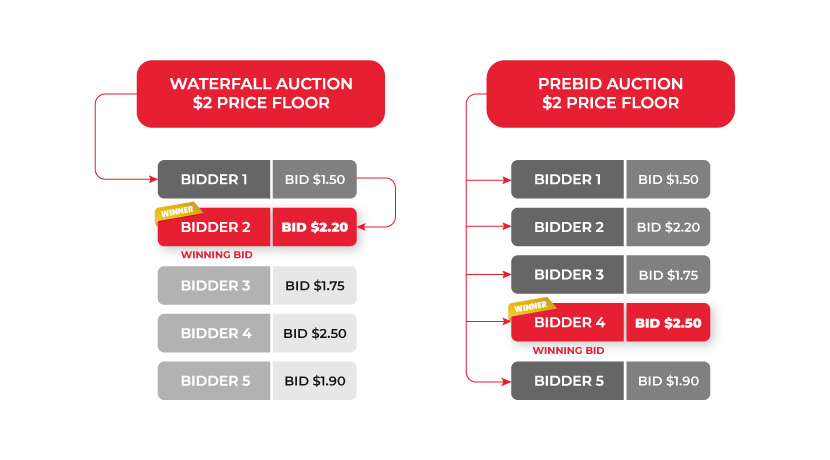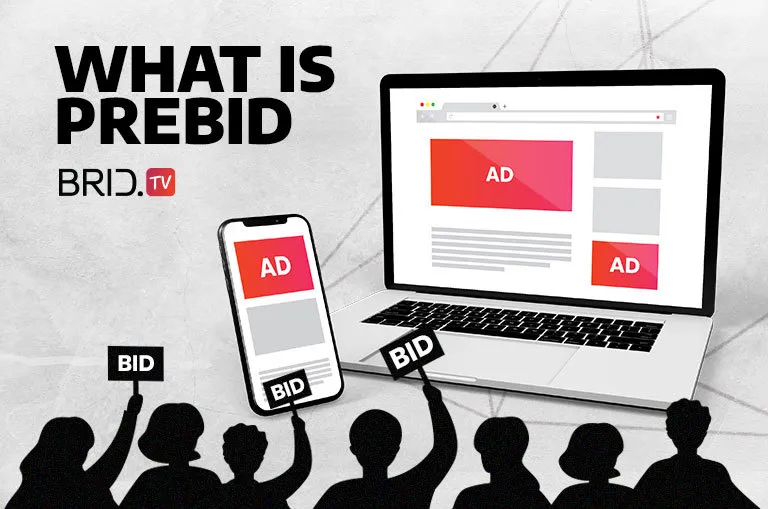If you’re part of the online advertising industry, you’re undoubtedly aware of the impact header bidding had on it. This advanced programmatic technique enabled publishers to reduce latency, increase ad yield, diversify demand, and cut down on passbacks.
However, header bidding technology was far from perfect when it first came out back in 2009. It was plagued with various issues in its early days like non-existing industry standards, lack of collaboration between providers, and incomplete solutions. But all of that changed when Prebid.js entered the scene in 2015.
Prebid.js organized the then-chaotic industry by introducing a reliable and easy-to-set-up standard, which quickly led to mass adoption of the prebidding technology across the globe. Nowadays, more than 66% of publishers use prebidding to ensure the best eCPM with the lowest latency.
But what lies behind this technology, how challenging is it to implement, and what makes it superior to other programmatic advertising techniques? Let’s find out!
What Is Prebid.js
Prebid.js, also known as a prebid wrapper, is an open-source solution that streamlines header bidding implementation on publishers’ websites and apps. As you can probably imagine, that made header bidding much more accessible. While publishers had to invest in entire tech teams to implement header bidding solutions in the past, Prebid.js made it possible to set everything up quickly and at minimal costs.
“Prebid.js is a feature-rich header bidding platform for the web with more than 150 demand sources and 15 analytics adapters supporting currency conversion, GDPR, common ID systems, and multiple ad servers.”
Prebid.js
Prebid offers publishers a rich library of effective adapters they can use to connect to thousands of demand partners to bid on their available ad inventory. When you combine this functionality with the customizability of its open-source software, you get the perfect header bidding solution publishers can adapt to their specific needs. That is why Prebid.js is the leading header bidding wrapper on the web currently.
You Might Also Like: Contextual Targeting 101: An Effective Way to Reach Your Target Audience
How Does Prebidding Work?
The core principle of prebidding is that it lets multiple demand partners bid on a publisher’s ad inventory nearly simultaneously. That allows publishers to sell their inventory to the highest bidder, maximizing their profit.
But how does this process work? Through prebid wrapper!
Whenever a user enters a website without a prebid wrapper on it, the ad tag on that page will send a request to an ad server. But if you have a JavaScript wrapper in your page’s header, that ad request will be delayed while the competing DSPs participate in real-time bidding. The entire prebid auction is carried out in a few simple steps:
- Once a user enters a website and an impression becomes available, the Prebid.js library starts fetching bids and creatives from ad exchanges and SSPs.
- Prebid.js forwards these ads and bids to the ad server.
- The ad server uses parameters like ad type, floor price, and ad format to evaluate these bids within the time limit set by the publisher.
- After evaluating all the bids, the ad server sends the winning bid’s details (if there is one) to the Prebid.js library to display the winning ad.
Thanks to prebid wrappers, publishers can streamline the management of their demand partners and add more bidders to their auctions seamlessly.
The Difference Between Waterfalling and Prebidding
Now that you know how prebidding works, let’s see how it compares to one of the most widely used programmatic techniques — ad tag waterfalling.
Both prebidding and waterfalling exist to help publishers boost their income — that much is clear. They may look similar at first glance, but waterfalling has one downside that makes it inferior to prebidding — its bidding system is linear.
What does that mean? It means that an ad tag waterfall will choose the first bidder that bids more than the price floor as the winner. However, that will not always be the highest bidder! Alternatively, since all bids in prebidding take place simultaneously, the winner will always be the demand partner with the highest bid. Here’s a side-by-side example of an ad tag waterfall and a prebidding auction:

As you can see, the second bidder ($2.20) will win in a waterfall auction since they’re the first one to bid over the price floor. However, considering that the highest bidder offers $2.50, the publisher loses out on $0.30 in such a scenario.
Since a prebidding auction takes all bidders into account simultaneously, the publisher sells their inventory for the highest price of $2.50, maximizing profit.
Publishers relying on waterfalling lose 12% of their potential revenue in this specific scenario, which is nothing to scoff at. And these numbers can get much higher for publishers with thousands, even millions of ad impressions.
So if you have the means to shift from a programmatic to a header bidding solution, it would be well worth it in the long run.
You Might Also Like: 12 Best Programmatic Advertising Platforms (Reviewed)
Benefits of Using Prebid
Aside from helping publishers drive more revenue, prebidding comes with multiple other benefits:
- Header bidding is smoother with a prebid wrapper, leading to faster response times, lower latency, and a better user experience overall.
- Prebid works with various types of ads, including display, native, and video ads on all devices.
- Publishers can seamlessly integrate Prebid.js with thousands of unique bidders from all around the world.
- Prebid comes with in-depth analytics publishers can use to gain invaluable insights into their ads’ performance to optimize their campaigns.
When you couple all of the above with the apparent revenue boost prebidding brings to the table, it’s unsurprising why prebidding is considered the future of digital advertising.
However, we should emphasize that getting started with prebidding comes with a few challenges.
Is Implementing Prebid.js Challenging?
Yes. Implementing Prebid.js does come with a few challenges, which is the primary reason many publishers have yet to switch to it. One of the primary obstacles for most publishers is that prebidding requires a dedicated ad ops team to deploy and manage successfully. Aside from that, meeting all the technical requirements might require a significant investment. This costly barrier to entry is why many small and mid-sized publishers have yet to move away from traditional programmatic.
Most Frequent Problems With Implementing Prebid.js
Here are a few most common problems with prebid implementation for publishers:
- Setting Up Line Items — This issue is the most common one for smaller publishers since setting up line items manually is time-consuming. So if you’re understaffed, you’re out of luck. Also, setting up line items properly requires expertise, and not anyone can do it. If you don’t set everything up perfectly, it can cause various discrepancies and make you lose revenue.
- Handling Google’s API — Setting up line items requires Google API know-how and some basic coding knowledge. This requirement is particularly problematic for smaller publishers without a dedicated development team, which is another reason many give up on prebidding.
- Setting Up Real-Time Analytics — Publishers need to have access to in-depth data on their creatives to maximize their revenue. Unfortunately, creating a system compatible with all demand partners to collect and analyze these statistics can be tricky and require quite a bit of technical expertise. The best solution for publishers without the necessary staff to handle this in-house is to get themselves header bidding analytics software. However, these can take a substantial cut of your revenue, which is a huge deterrent for some publishers.
Despite the hurdles above, prebidding is the most reliable way to boost your ad revenue while ensuring high fill rates. So if you’re aiming for long-term success and are prepared to invest some money, changing from programmatic to prebidding is the way to go.
You Might Also Like: Video Header Bidding: A Beginner’s Guide for Publishers
Prebidding at TargetVideo
Even if you lack the resources and staff to handle all your prebidding needs in-house, you can still implement it and scale your monetization efforts. That’s where third-party prebidding solutions come into play.
For publishers whose primary source of income is video ads, TargetVideo’s prebidding solution could prove the perfect choice. Our lightweight HTML5 player has built-in prebid functionality with access to top-level ad inventory. Publishers can integrate Google ADX, Prebid.js, and Amazon Publisher Services prebidding into our video player in just a few clicks without any coding knowledge.
Publishers can access these and many other monetization options directly from our video CMS.

Once you enable prebidding, you can add multiple SSPs for each ad slot without much hassle. All you need to do is select your desired SSPs from our wide selection of easily configurable templates in the “Prebid Setup” section.

This feature means even beginners can easily set up prebidding without having to write custom code for each SSP.
Instead of spending a small fortune on an in-house prebidding team and doing everything manually, why not cut costs with a tried-and-tested solution like TargetVideo? Tell us your goals, and let’s scale your ad-powered business together!
